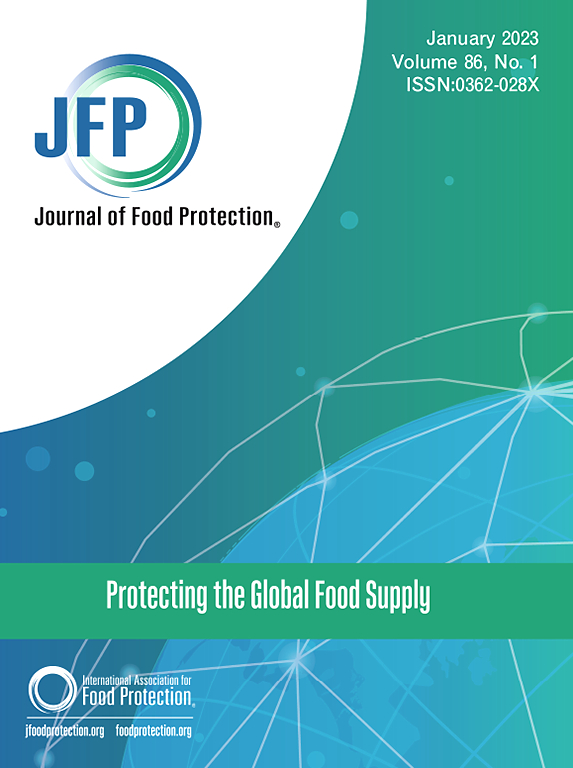调查饲养场使用直接饲喂微生物菌剂对大肠杆菌 O157:H7 粪便脱落的影响。
IF 2.1
4区 农林科学
Q3 BIOTECHNOLOGY & APPLIED MICROBIOLOGY
引用次数: 0
摘要
我们的目标是确定饲养场一级使用直接饲喂微生物制剂(DFM;Lactobacillus animalis LA51和Propionibacterium freudenreichii PF24;Bovamine Defend®,2x109 CFU/g)是否与粪便中大肠杆菌O157:H7的流行率和浓度有关,并确定与商业饲养场运营的牛栏中粪便中大肠杆菌O157:H7流行率有关的牛栏和饲养场一级风险因素。2017 年夏季,对内布拉斯加州的 20 个商业饲养场进行了采样,其中 10 个包括 DFM(DFM),10 个不包括 DFM(无 DFM)。在每个采样月,从每个饲养场的三个围栏中收集了 22 份栏底粪样。对样本进行文化和分子程序检测大肠杆菌 O157:H7(免疫磁分离、在选择性培养基上培养,然后进行 PCR 确认),并进行螺旋培养定量。对来自 20 个饲养场 180 个育成牛栏的 1,320 份样本进行了处理和检测,这些样本在 12 周内采样三次。在所有饲养场和采样月份中,栏内平均流行率为 13.5%(95% CI = 2.6-47.4%)。DFM 状态与圈舍内大肠杆菌 O157:H7 感染率之间的关系显著(p本文章由计算机程序翻译,如有差异,请以英文原文为准。
Investigation of Feedlot-level Use of a Direct-fed Microbial on Fecal Shedding of E. coli O157:H7
Our objectives were to determine whether the feedlot-level use of a direct-fed microbial (DFM; Lactobacillus animalis LA51 and Propionibacterium freudenreichii PF24; Bovamine Defend®, 2 × 109 CFU/g) was associated with fecal prevalence and concentration of E. coli O157:H7, and determine pen- and feedlot-level risk factors associated with fecal E. coli O157:H7 prevalence in cattle pens from commercial feedlot operations. Twenty commercial feedlots in Nebraska, ten that included DFM (DFM) and ten that did not (no-DFM), were sampled during the summer of 2017. In each sampling month, 22 pen-floor fecal samples were collected from three pens in each feedlot. Samples were subjected to cultural and molecular procedures for the detection of E. coli O157:H7 (immunomagnetic separation, plating on selective media, followed by PCR confirmation) and spiral plating for quantification. A total of 1,320 samples from 180 pens of finishing cattle belonging to 20 feedlots, which were sampled three times throughout a 12-week period, were processed and tested. Across all feedlots and sampling months, the mean within-pen prevalence was 13.5% (95% CI = 2.6–47.4%). The association between DFM status and the within-pen prevalence of E. coli O157:H7 depended significantly (p < 0.05) on the sampling month. The second sampling month between late July and mid-August corresponded to the highest within-pen prevalence estimates reported in this study, with no-DFM pens having a higher prevalence than DFM pens. After accounting for the DFM status, and based on multivariable analyses, sampling month, average pen body weight, and weather conditions were significantly associated with the within-pen fecal prevalence of E. coli O157:H7. Collectively, these findings demonstrate that the use of a DFM containing Lactobacillus animalis LA51 and Propionibacterium freudenreichii PF26 in feedlots showed potential in reducing fecal E. coli O157:H7 prevalence in cattle during times when prevalence peaks.
求助全文
通过发布文献求助,成功后即可免费获取论文全文。
去求助
来源期刊

Journal of food protection
工程技术-生物工程与应用微生物
CiteScore
4.20
自引率
5.00%
发文量
296
审稿时长
2.5 months
期刊介绍:
The Journal of Food Protection® (JFP) is an international, monthly scientific journal in the English language published by the International Association for Food Protection (IAFP). JFP publishes research and review articles on all aspects of food protection and safety. Major emphases of JFP are placed on studies dealing with:
Tracking, detecting (including traditional, molecular, and real-time), inactivating, and controlling food-related hazards, including microorganisms (including antibiotic resistance), microbial (mycotoxins, seafood toxins) and non-microbial toxins (heavy metals, pesticides, veterinary drug residues, migrants from food packaging, and processing contaminants), allergens and pests (insects, rodents) in human food, pet food and animal feed throughout the food chain;
Microbiological food quality and traditional/novel methods to assay microbiological food quality;
Prevention of food-related hazards and food spoilage through food preservatives and thermal/non-thermal processes, including process validation;
Food fermentations and food-related probiotics;
Safe food handling practices during pre-harvest, harvest, post-harvest, distribution and consumption, including food safety education for retailers, foodservice, and consumers;
Risk assessments for food-related hazards;
Economic impact of food-related hazards, foodborne illness, food loss, food spoilage, and adulterated foods;
Food fraud, food authentication, food defense, and foodborne disease outbreak investigations.
 求助内容:
求助内容: 应助结果提醒方式:
应助结果提醒方式:


